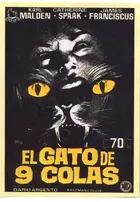
In comparison to an Umberto Lenzi giallo, for example, Il gatto still possesses a remarkable finesse, but I still doubt that the latter will be hailed as an anthem for authorship.

Breathless praise of Il gatto's stunning print quality and widescreen presentation has veiled over the film's narrative shortcomings. To put it bluntly, Il gatto a nove code is the least inspiring of Argento's Italian-made gialli, although I doubt that many would admit this (as the recent plethora of critical evaluation of the Anchor Bay DVD has illustrated). My commentary on the later two films is intended as neither a synopsis nor an exhaustive critique, but as a personal interpretation and an initial attempt to articulate points that may have been overlooked in other Argento studies. This trilogy served to shape the giallo in the 70s and formed the kernel of Argento's obsessions and idiosyncrasies. Il gatto a nove code ( The Cat O' Nine Tails, 1971) and Quattro mosche di velluto grigio ( Four Flies on Grey Velvet, 1972) are the second and third entries in Dario Argento's so-called "Animal Trilogy," following L'Uccello dalle piume di cristallo ( The Bird With the Crystal Plumage) in 1970.

In this "personal interpretation" of two of Argento's earliest films, Gary Needham looks at how each one relates to the giallo form, identifying points of reference and divergence and raising central issues of gender dynamics and the Italian horror film's fixation with boundary transgression and breakdown.


 0 kommentar(er)
0 kommentar(er)
